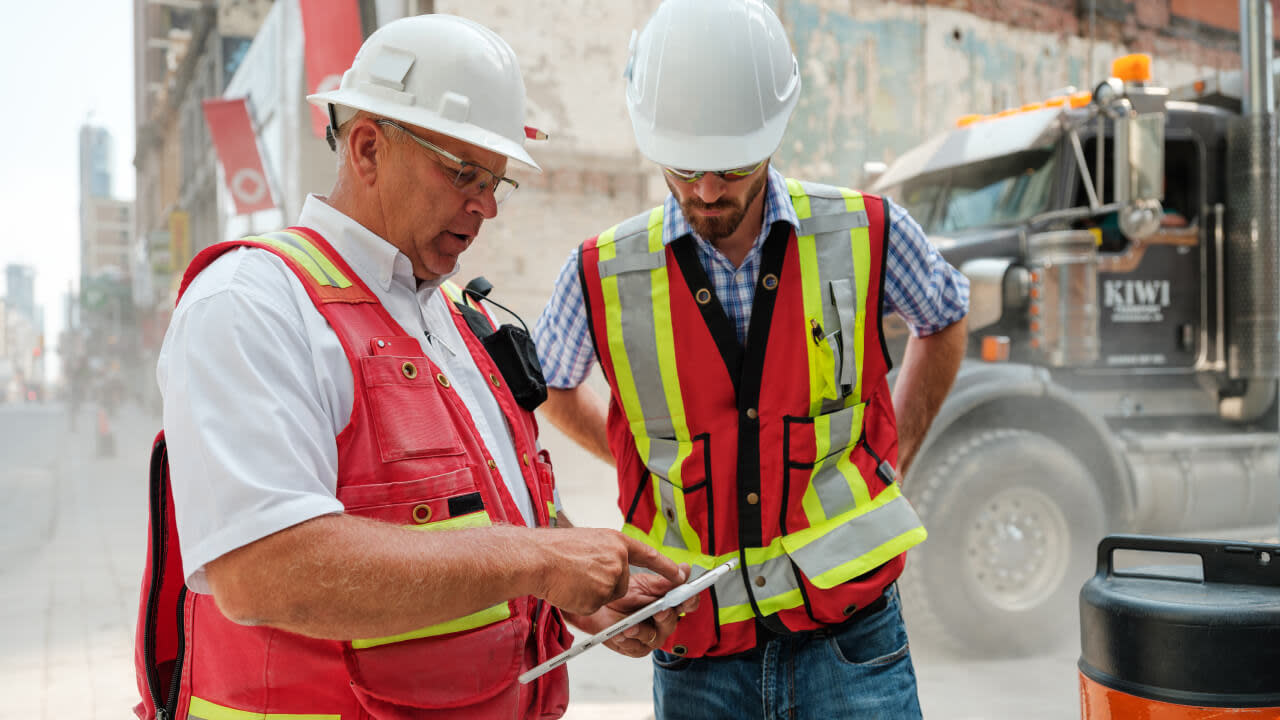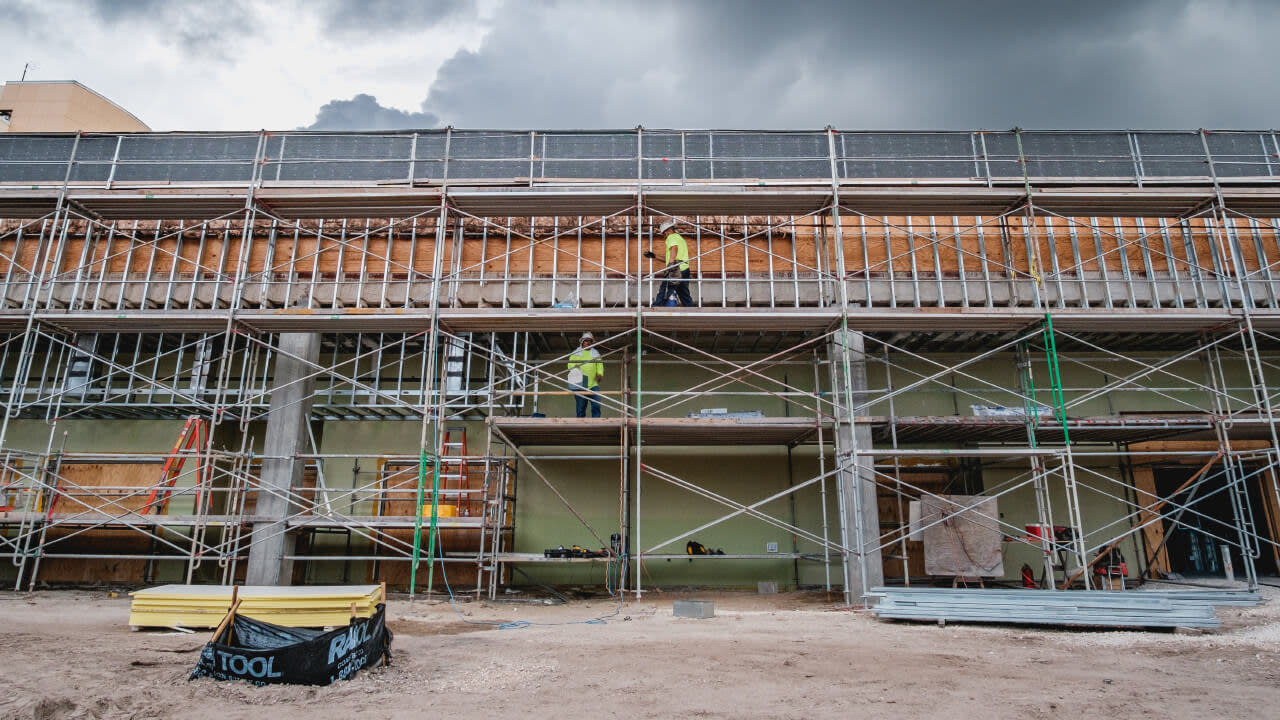
Article
What is Construction Management?
A definitive guide with definitions, construction project manager responsibilities, salary, and more.
Want to learn more? We’re here to help
If you’re wondering, “what do construction managers do?”—you’re in the right place. For those in a hurry, we’ve provided a table of contents below to help you find the specific section you’re looking for.
Whether you’re just starting out in the industry or you’re an open-minded expert who wants to know how the role has changed and will continue to do so in this new decade, this definitive guide provides an overview of everything you need to grow as a construction manager.
Let’s dig in.
Chapter 1
Construction Manager at a Glance
2018 National Median Pay: $93,370 per year; $44.89 per hour SOURCE: BLS
Entry-Level Education/Prerequisites: B.A. in Construction Management, Construction Science, or related field
Entry-Level Work Experience Needed: yes, dependent on level of education
Additional Certifications: Construction Management Association of America SOURCE: CMAA
Soft Skills: Leadership, collaboration, customer-service, decision-making, public speaking, time management, writing, budgeting, technology and innovation
Gender breakdown: 91.5% male, 8.5% female SOURCE: PAYSCALE
Ethnicity breakdown: 89.3% white, 3.43% black, 7.27% other SOURCE: PAYSCALE
Average Age: 45.3 SOURCE: DATAUSA.IO
Stress Level: HIGH
Room for growth: HIGH
It’s oversaid, but it’s true—construction hardly ever closes out on time and on budget.
Have you ever? Because, if so, I’d like to shake your hand.
If you haven’t, you’re not alone. Large projects typically close out 20% past the original delivery date and run 80% over the original budget.
Even if you can’t completely prevent overruns, owners who take additional precautions to make sure that their investments get built on schedule and on budget have an opportunity to boost value added by a combined $1.6 trillion.
Enter: the construction manager.
Here’s a look at the profession of construction management, why owners choose to contract them, and all of the reasons why it was named by U.S. News & World Report as 2020’s #1 job in construction.
Chapter 2
What Is Construction Management?
Construction Management Definition
According to the Construction Management Association of America (CMAA), a U.S. construction management certification and advocacy body:
“Construction management is a professional service that provides a project’s owner(s) with effective management of the project's programme, cost, quality, safety, scope and function. Construction management works for all project delivery methods. No matter the setting, a Construction Manager’s (CMs) responsibility is to the owner and to a successful project.”
Construction Job Title Hierarchy
To fully understand how construction managers ensure successful projects, let’s put it within the context of the four various project stakeholders in the construction job title hierarchy.
The Owner: An individual or business entity who commissions and funds a project. Owners come from many different industries—property, development, healthcare, education and more. Many don’t have dedicated construction oversight teams and choose to contract out the work to a certified construction manager.
The Construction Manager: The person or team hired by the owner to provide oversight of the entire project’s delivery—from planning and preconstruction through construction and turnover.
The Licensed Architect and/or Engineer: The person or firm hired by an owner to manage project design and technical coordination between engineering disciplines.
The Main Contractor: The team hired by an owner to oversee day-to-day construction operations and subcontractor productivity during construction.
Construction Management Phases
1. Planning
You get what you plan for. Measure twice, cut once. A stitch in time saves nine.
Whichever phrase you prefer—the main lesson here is that carefully coordinated pre-planning is the first major phase of risk mitigation. During this phase, the owner defines:
Why there is a need for a building
What their goals and success metrics will be
How the needs and goals will impact the design
Scopes for budget and timeline
Simultaneously, the construction manager works with the architects, engineers, and other hired consultants to agree on the feasibility of those goals and do their best to plan ahead for potential construction setbacks.
The construction manager will also research which delivery method is most appropriate considering the task at hand. Just because design-build is the traditional way of delivering construction projects, it does not mean it is the best. In fact, the adversarial relationships engendered by design-build often add more stress, cost, and risk to project outcomes.
At best, design-build can provide owners with a fixed price contract to start with. But unless it is a traditional project with few unknowns, it is likely the price will change. This can damage relationships and lead to cut corners from contractors.
The greater the risks at the beginning, the more important it is to plan correctly around the right delivery method to avoid additional costs. Nevertheless, the greater the risks at the beginning, the greater the chance for additional costs.
Recommended read: “Owners—How to Build a Better Project from the Start”.
2. Preconstruction
During preconstruction early plans are submitted for building permits and main contractor tenders. This could include construction management contracts, drawings and specifications.
Meanwhile, the construction manager is in charge of hiring all construction teams and utilising risk management best practices to ensure that issues are resolved prior to the start of construction. Proper risk management minimises the amount variations and delays down the road.
3. Construction
Planning is done. The main contractor breaks ground. Execution begins.
During construction, the construction manager oversees:
Quality control inspections
Site investigations
Monitoring main contractor safety programmes
Monitoring insurance
Answering RFIs
Reviewing and approving technical submittals
Coordinating permits
Managing the budget
Scheduling timely payment for work completed
Ensuring the project is delivered as designed
All of this keeps the project moving smoothly while keeping stakeholders informed and satisfied.
4. Close Out
Snag lists are completed. Keys and as-builts are handed over to the owner.
Management of the building is officially “turned over” from the construction manager and main contractor to the owner.
The owners must be provided with all project information and close out documents such as manuals, warranties, as-builts and closed out ledgers. Insurance must also be changed from the course of construction to permanent property insurance. And in some cases, the owner is trained on how to use and manage their facility.
Chapter 3
Systems And Tools Used In Construction Management
If you ask any risk management consultant, they’ll tell you the truth: the real silent killers aren’t nightmarish doomsday risks but the poor processes that plague a construction manager’s every day.
Risk management and causes of failure
In a study called “Identifying Key Risks in Construction Projects: Life Cycle and Stakeholder Perspectives”, researchers analysed the top 10 risks that are most likely to occur and have a significant impact on your project objectives. In order of importance, they are:
Tight project programme
Design variations / variations by the client
Excessive approval procedures
High performance and quality expectations
Poor project management techniques
Lack of coordination between project participants
Unavailability of sufficient skilled professionals
Incomplete approval and other documents
Incomplete or inaccurate cost estimates
General safety
Luckily, there are construction management platforms that can help create a 3,000-foot view of a project and make it easier to predict and prevent poor micro practices from infringing on project success.
Recommended read: “Mitigating Risks: 10 Micro Practices that Threaten Your Daily Objectives”
Dedicated Construction Management Software
In 2017, McKinsey & Company released Reinventing Construction: A Route to Higher Productivity. In the report, researchers found that the construction sector is one of the largest contributors to the world economy, with about $10 trillion spent on construction-related goods and services every year. However, the industry’s productivity has trailed that of other sectors for decades, and there is a $1.6 trillion opportunity to close the gap.
In the span of a generation, many construction industry design and management processes have been transformed. Designs that used to be created and updated on drawing boards by hand are now generated and amended on computer screens.
The drawings themselves are no longer printed, copied, folded and then posted. Today, they’re sent as email attachments or shared with online collaboration platforms like Dropbox or Google Drive. And double-entry bookkeeping in traditional ledgers is now managed via Excel or industry-specific finance and accounting software like Sage or Viewpoint.
Despite all of this, the construction industry is still a long way from being truly digitally transformed. According to the McKinsey Global Institute, it is almost at the bottom of the US digitisation league, just above agriculture and hunting, while the Gartner IT Key Metrics show construction has consistently ranked last in terms of investment in technology.
Spending in construction averages just 1.2% of revenue, with over a third of companies spending under 1%. This lack of adoption and reliance on old-school, manual methods perpetuates preventable mistakes that make construction a low-margin business.
According to JB Knowledge’s 2019 Construction Technology Report:
40% of construction companies are still using paper plans on the job.
Nearly 50% of the construction professionals manually prepare and process daily reports.
Of those who do use software, 53% of construction professionals manually transfer data between the apps they use to manage projects.
Of the construction management apps preferred by both main contractors and construction managers, Procore was ranked as the #1 used project management software. You can read JB Knowledge’s full report, here.
Recommended read: “The Rising Tide of Software Integration”
Logs
One of the recommendations that the JB Knowledge report gave for making improvements in 2020 were prioritising, and budgeting for, software integrations. Even at additional expense, technology that integrates to allow communication between workflows and departments for cross-functional teams can reduce a construction manager’s stress, optimise their use of time, save the project money, increase productivity, and minimise miscommunication.
As the main centre for communication and collaboration between teams, digitising site diaries is an impactful place to start.
RFI Logs
Requests for Information (RFIs) are upstream requests (ex: questions from MCs for their engineers, architects or owner) for greater clarity about contractual obligations, agreements, drawings or specifications. They take time and manpower, and are usually necessary due to the siloed nature of construction disciplines.
Architects design the building.
Engineers deduce how to build it safely.
Contractors oversee the actual construction.
Operational silos like these are good and necessary. They allow for individual teams within an organisation to use their specific expertise, apply it to an individual task, and take ownership and responsibility of their work.
However, these swimming lanes also create the need for information exchange and request for clarity between parties. For example, when tendering or allocating resources for a project, main contractors may have questions for the engineer about specifications that may impact the amount or quality of materials that need to be ordered from a vendor. The MCs need to wait for clarity from the engineer before proceeding at risk, which holds up the progress of a job and leads to additional costs and delayed delivery.
In an effort to monetise the costs RFIs create for construction firms, Navigent Construction Forum of Navigant Consulting, Inc. reviewed RFI data from 1,362 projects worldwide for a total of 1,083,807 RFIs. The projects ranged in value between $5 million and $5 billion, and each one had an average of 796 RFIs.
The research revealed that RFIs can create significant backlogs, since owners and project managers are required to review and respond to each individual RFI from contractors and subcontractors, noting the cost of each one and the use of the process to make claims against owners.
The study revealed that the cost of reviewing and responding to each individual RFI, can cost an average of $1,080, while the collective cost to the project could set a firm back $859,680.
In addition, whether due to requests not considered by the design team, questions already answered in the original contract, or because they are focused on means and methods, more than one in ten of the RFIs were listed as "unjustifiable". Collectively, these unjustified RFIs averaged about $113,400 per project.
Contractors who implement construction project management software can effectively eliminate these delays by making RFIs available to all relevant parties instantaneously.
Phone Logs
Construction managers travel often while coordinating multiple different teams and projects. Keeping records of phone logs to document processes is a best practice and form of CYA (read: risk management) to ensure payment. Some software automatically records phone logs, meeting agendas and minutes.
Delivery Logs
More often than not, delivery logs for materials and equipment will be managed by the jobsite site manager, project manager or other job description on the main contractor’s team. As a lead coordinator, construction managers will need visibility into this. Digital delivery log software would make it easy for the CM to view on the go.
Labour Planning Documentation (PERT CPM)
Deadlines mean different things to different stakeholders. A practical construction manager knows that programmes are always in flux. Meanwhile, owners have their eyes on the bottom line at all times. If substantial completion isn’t met according to the contract you’ve signed, you could be at risk for a lawsuit.
Missed deadlines and project delays are one of the most common reasons for arbitration, second to only cost overruns. This is where the critical path method can help.
The Critical Path Method (CPM) allows for lists of activities to be linked in order of dependency. For example, you can’t pour cement until rebar has been set and you can’t build the second floor of a building before you’ve built the first. For these reasons, the Critical Path Method is great for proving due diligence in the unfortunate case of a delay dispute. The basics of CPM are cause and effect.
The Critical Path Method is only as powerful as the data that you enter into it. If estimates are off, or man-hours aren’t calculated correctly, you may end up with delays and cost overruns. So don’t automatically consider a CPM chart to be the ultimate truth.
Unfortunately, it overcomplicates the view of daily tasks and progression timelines for those in the field who need to take a quick glance at the status of a project. But, a properly thought out programme allows the construction manager, contractor and owner to coordinate the work and labour resources that are needed to complete projects in a timely manner.
Recommended read: “Construction Manageent's All-In-One Solution”
Chapter 4
Construction Project Manager Job Description & Key Functions
A construction project manager’s job description is simple when observed through the lens of the project management triangle. Summed up as “fast, good, or cheap...pick two,” the concept asserts that there are firm boundaries on what is possible to produce.
The triangle metaphor implies there is no way to provide goods or services that are simultaneously on budget, on time, and of high quality because of the competing nature of these priorities.
It’s the construction manager’s job to defy that notion and deliver all three to their owner.
To do so, they work with all parties—architects, engineers and main contractors—and take responsibility for budget, construction management contracts, risk management planning and management of the team to meet overall design and construction milestones. All according to the owner’s expected standards of quality, scope and function.
According to the CMAA, when fully broken down, there are over 120 construction project manager responsibilities—all of which fall into these seven key functions:
Project management
Cost management
Time management
Quality management
Contract administration
Safety management
Construction management professional practices (manage the team working on the project, define each person’s role and responsibilities, etc.)
Setting Project Scope
A construction project’s scope of work (SOW) generally refers to the list of obligations—what is to be built, for how much and by when—that a contractor, subcontractor, material supplier or equipment supplier is to produce or install for the owner.
Construction Management & Programming
Once all initial planning and tendering has informed the project programme, it is the construction manager's job to notify contractors of that programme. That way main contractors can schedule labour, equipment and materials with vendors accordingly.
As the liaison between the owner and construction, each construction manager must also delegate tasks to the rest of their team. Including estimators, surveyors, designers and builders.
Recommended read: “Don’t Let Scope Creep Sneak Up On You”.
Allocating Resources
In chess, grandmasters run permutations of decision trees with moves and countermoves. Allocating resources is no different.
There are 3 major types of resources in construction: labour, materials and equipment.
Once the project scope is set, allocating the proper resources begins. This includes everything from coordinating workers to their jobsites, organising the timely delivery of building materials and securing equipment and tools.
Many owners, construction project managers and main contractors work on more than one project at a time, limiting the pool of available resources at their disposal. Like a master chess player—the construction manager has to see who is available on those specific days and times, what equipment they’re going to need or purchase, and where the jobsite is.
If there’s too much coverage, the budget increases at the risk of paying people to stand around and wait for something to do. Not enough coverage, and you’ll be slowing down the build. It’s a tough balancing act, but there are tools that can help.
Recommended read: Tracking Technology Helps Construction Companies Save Money
Coordinating Operations
Construction managers consult on which teams to hire or not based on their risk assessment, obtain work permits, troubleshoot emergencies, programme walkthroughs and keep the owner informed on the progress on a project.
Maintaining Communication Between Parties
Construction managers work for the owner’s interest. But other parties, like main contractors, subcontractors and designers, are ultimately working to get paid and protect their bottom line.
When overseeing architects, surveyors, main contractors, speciality contractors and others, it is important that all these members of the project staff are managed effectively so that everyone is working toward the same goal of producing the best work for the owner.
Chapter 5
What Does A Construction Manager Do During Each Stage of Construction?
Construction Management Process on Jobsite
What construction managers do during each phase of construction is largely dependent on the project’s delivery method.
Project delivery methods
Integrated Project Delivery (IPD) is a method that pulls together all project teams, from the architect to main contractor to owner and interior designer, in order to take advantage of all key stakeholder knowledge and maximise the best project outcome. IPD is the highest form of collaboration because all parties are joined by a single contract. To learn more about IPD, read “
Integrated Project Delivery: A Guide to Seamless Construction Projects”.
In design-tender-build delivery (DTB), owners contract the design firm that produces the
construction documents and the builder that physically builds the building, separately. This is the traditional method of delivery and is based on the sequential process of design, construction documents, tendering and then construction.
In design-build projects, “the owner manages only one contract with a single point of responsibility. The designer and contractor work together from the beginning, as a team, providing unified project recommendations to fit the owner's programme and budget. Any changes are addressed by the entire team, leading to collaborative problem-solving and innovation, not excuses or blame-shifting. While single-source contracting is the fundamental difference between design-build and the old ways, equally important is the culture of collaboration inherent in design-build.” To learn more about design-build, read
“What is Design-Build” by the Design-Build Institute of America.
Tendering
During the tendering process the construction manager consults on which contractors to hire—price is just one component of that. They are also in charge of assessing the level of risk of each contractor to ensure that all safety, financial and insurance records don’t present any red flags about why their tender should not be accepted.
Feasibility
Feasibility studies are generally conducted during the planning process to determine if the project is viable and whether or not additional capital investment or financing is needed. Feasibility studies generally consist of land surveys, building permits, zoning laws, impact reports on the surrounding environment and natural habits, traffic issues and general impact on businesses in the area as well as the overall market opportunity.
Pre-Construction
The construction manager is in charge of prequalifying and procuring the professional teams. This mostly consists of managing contracts and insurance, accepting tenders from main contractors, assessing the level of risk of each potential main contractor, and incorporating all of their rough estimates of scope into the total project budget and programme.
Procurement
Procurement is a process in the pre-construction phase in which the construction manager helps to acquire tenders for equipment, materials and construction services. They then technically and commercially evaluate those tenders and issue purchase orders and negotiate construction contracts.
Construction
Construction managers oversee the daily operations of main contractors, speciality contractors, vendors and other project staff. Their main goal during construction is to make sure the project runs according to programme and budget.
Change management
On a construction project, a change event is any change that affects the original scope of a construction project. It can be any event that affects the scope of the work to be completed, causes a change to the project programme or results in unexpected costs. While the quantity and scope of variations can certainly be reduced with proper design and planning, any decent-sized project will have them. Planning for this eventuality upfront and having the proper systems and procedures in place is crucial for setting everyone up for success.
To learn more, read “Change the Way You Think About Variations”
Occupancy
Occupancy is the phase in post-construction after the completion of the build and close out of all snag lists. Keys, as-builts and other information that the owner needs to manage their new building must be handed over. The owner prepares to open doors for business. Refer back to “Close Out” for more information.
Delegating Tasks
Allocating resources in construction is one of the biggest chess games of a construction manager’s life. As the main liaisons between the owner and construction, each construction manager delegates tasks to their team of estimators, surveyors, designers and builders, all while orchestrating the progress of each toward one singular goal—on time, on budget and quality builds.
Notifying Contractors Of Programming
Once all initial planning and tendering has informed the project programme, main contractors need to be informed so that they can schedule labour, equipment and materials with vendors accordingly.
Chapter 6
Construction Manager vs. General Contractor: What’s The Difference?
Both the construction manager and main contractor job descriptions describe themselves as the head contractors on the job. Which is why it’s not surprising that many find it difficult to distinguish main contractors from construction managers.
If you’re choosing between a career as a construction manager vs main contractor, this can give you an idea of the difference between the job descriptions.
Beyond their similarities, main contractors and construction managers have fundamentally different organizational structures, business relationships with owners, and levels of involvement with the project. Here are just a few of the main differences.
Construction Manager | Project Manager for Main Contractor | |
Hiring Process and Level of Involvement | Hired by owners during planning or pre-construction. Advises the project owner when hiring main contractors, designers and architects and more. | Chosen by owners through a tendering process Become involved during the construction phase. |
Responsibilities | Collaborating with engineers and architects assigned to a project to make sure it runs smoothly Hiring low-level managers to oversee particular parts of a project Creating project budgets and work activity timelines Analysing and providing guidance on contracts or technical material to colleagues | Examining construction diagrams and contract terms to set an appropriate tender amount to present to the client Communicating with the project architect during the construction phase Hiring reliable subcontractors to handle specialised work, such as plumbing or electrical work Ensuring all work is completed correctly and on time |
Organisation structure | An individual or teams of consultants. Not rank and file employees who perform the actual construction. They are estimators, project managers, accountants or other professionals with responsibilities that come into play before, during and after a project. | Business entities with their own site and office employees like executives, administrators, finance, project managers, site managers, foreman. Hire their own network of trusted business partners like speciality subcontractors and vendors. |
Owner Relationship | Perform their functions at the behest of the owner. The CM assists during preconstruction by hiring subcontractors, or on larger projects, one or more main contractors. Work from a predetermined fee so they aren’t in a competitive relationship with the owner, in which they are trying to keep costs down so they can make a profit on their tender amount. | MCs get new projects through competitive tendering and are therefore third parties in a construction process from the start. The MC provides a set price and builds all aspects of the project that are covered in the contract. If the MC manages to spend less than the tender price, then profit is made. When unforeseen issues arise, as they usually do, and they aren’t already included in the contract, then the owner must pay additional fees to cover the costs, change the specifications or reduce the project’s scope. |
Recommended read: “The Differences Between Main Contractors and Construction Managers”
Construction Manager’s Place In The Construction Job Title Hierarchy
Construction managers are hired from the very beginning of planning a capital project. They develop and participate in the pre-construction process—they offer input regarding the realities of costs, features, specifications and materials—to help arrive at more accurate estimates. Because the CM gets involved in the project early, he or she can recommend adjustments to processes and materials to achieve higher value in the end.
Chapter 7
How Much Do Construction Managers Make?
In 2018, Construction managers earned a median salary of $93,370. The best-paid 25 percent made $123,720 that year, while the lowest-paid 25 percent made $70,670.
Average Construction Manager Degree Salary vs. Other Construction Jobs
Construction managers earned an average salary of $103,110 in 2018. Comparable jobs earned the following average salary in 2018: Architects made $88,860, Cost Estimators made $69,710, Plumbers made $58,150, and Carpenters made $51,120.
For more information, check out the Bureau of Labor Statistics’ information on Construction Management Salaries (BLS).
Construction Management Salary: Entry Level Positions
According to Payscale, an entry-level Construction manager with less than 1 year experience earns an average total compensation of $55,947.
An early career Construction Manager with 1-4 years of experience earns an average total compensation of $61,644.
Construction Management Salary For Medium and Experienced Workers
Mid-career Construction Managers with 5-9 years of experience earn an average total compensation of $74,475. An experienced Construction Manager with 10-19 years of experience earns an average total compensation of $82,914 based.
Construction Manager vs Main Contractor Salary
As a leader on the jobsite, construction managers are held to higher education and experience standards than someone who is applying for a position as a project manager at a main contractor. Because of this, and the greater scope of ownership that construction managers in a project, they often earn higher salaries than other construction occupations.
Chapter 8
How To Become A Construction Manager
If you’re wondering how to become a construction project manager, start by learning the profession. The most common path to becoming a construction manager is by earning a bachelor’s degree and learning management techniques through on-the-jobsite training.
Education
There is no single right way to learn about construction management. However, construction managers tend to have a bachelor’s degree in construction science, construction management, architecture or engineering. According to datausa.io with input from the U.S. Census Bureau, the majority of construction managers have opted for degrees in engineering or business.
There are over 100 universities nationwide that offer accredited bachelor’s degree programmes in construction science, building science or construction engineering. These programmes are comprised of courses on project control and management, design, construction methods and materials, cost estimation, building codes and standards and contract administration. Courses in mathematics and statistics are also relevant.
In addition to that, there are over fifty 2-year colleges that offer construction management or construction technology programmes. An associate’s degree combined with work experience is typical for managers who supervise smaller projects.
A few universities offer master’s degree programmes in construction management.
For a full list of available schools, visit study.com.
Training
New construction managers and interns are typically hired as assistants under the guidance of an experienced manager. This training period may last several months to several years, depending on the stage you are at in your education.
Work Experience in a Related Occupation
For those who decide to forego the typical classroom education, practical construction experience is mandatory. Internships, education programmes and previous work in the construction industry can provide that experience. Some construction managers become qualified after spending the majority of their early years in a specialised trade like carpentry, masonry or other construction specialities.
Licences, Certifications and Registrations
Although certification is not a requirement in some counties (for your county's requirements,, contact your county licensing board), most large clients will only hire those with proof of certification as a way to judge competency.
The Construction Management Association of America awards the Certified Construction Manager (CCM) designation to workers who have the required experience and who pass a technical exam. It is recommended that applicants for this certification complete a self-study course that covers the professional role of a construction manager, legal issues, the allocation of risk and other topics related to construction management.
Educational Requirements
The first step on the journey to becoming a construction manager is earning a bachelor’s degree in construction management or another related field. Here’s what that looks like.
Step 1: Get an education
According to datausa.io with statistics provided by the Department of Education, Census Bureau, and ACS PUMS 1-Year Estimate, degrees in construction are actually the 3rd most popular degree chosen by those who end up in construction management roles. The most popular bachelor’s degree chosen was Engineering.
Pro Tip for those getting started: Apply for an internship. Internships provide experience in the field and can help with landing a job after graduation.
Professional Experience Requirements
Step 2: Professional Experience
The second step to becoming a construction manager is gaining experience. Prospective managers might work as management assistants after graduation. Such work experience provides first-hand knowledge of construction site operations. Construction management firms may provide training to prospective managers to prepare them for advancement opportunities.
Step 3: Certification
Through the Construction Management Association of America (CMAA), individuals can attain the Certified Construction Manager (CCM) voluntary designation. Prospective CCMs with a bachelor's degree must meet particular work experience requirements, including four years of construction management experience, before applying and taking a test. Those without a degree who have eight years of construction experience plus four years working as a construction manager can also apply. CCMs must also submit to an ongoing recertification process every three years, which involves a combination of professional development and work experience.
Step 4: Get a Construction Master's Degree for Career Advancement
Certified construction managers looking to further advance in their careers may want to pursue a master's degree programme in construction management. Graduate-level studies in the field emphasise practical applications of key management principles. Courses include construction materials and methods, labour relations, safety, public policy and construction management practices.
Job Outlook
Great news—the Bureau of Labor Statistics projects 9.8 percent employment growth for construction managers between 2018 and 2028. In that period, an estimated 46,200 jobs should open up—almost twice as much as the national average for all other occupations.
This is mostly due to a combination of population and economic growth. To keep up with the global economy, new homes, office buildings, retail outlets, hospitals, schools, restaurants and infrastructure will need to be built, upgraded and retrofitted, or replaced.
Secondly, the aging of America’s workforce will cause a mass retiring of construction managers who are expected to retire or leave the occupation in substantial numbers over the next decade, resulting in further job openings.
Chapter 9
Frequently Asked Questions About Pursuing Construction Management
What can you do with a construction management degree?
Even if you decide to change your career path, having a degree in construction management can open doors for you in the rest of the industry. Some routes to consider are: estimating, purchasing, quality and safety compliance, or in the field as a site manager.
Whatever your area of interest, the answer to what can you do with a construction management degree is limitless.
How do you get into construction management?
If you’re wondering, “how do you get into construction management?”, here’s the cliffnotes version:
Step 1: Earn a bachelor’s degree in construction management or a related field.
Step 2: Gain at least 4 years of construction management experience—many begin as assistants to head construction managers on the jobsite.
Step 3: Get certified by the Construction Management Association of America (CMAA). Or, earn the Certified Construction Manager (CCM) voluntary designation. Prospective CCMs without a bachelor’s degree must have 8 years of construction experience plus four years working as a construction manager before applying to take the CCM certification test.
Step 4: Keep learning! All CCMs must also submit to an ongoing recertification process every three years, which involves a combination of professional development and work experience. Certified construction managers looking to further advance in their careers may also want to pursue a master's degree programme in construction management.
Why study construction management?
Here’s the hard, cold truth: construction management is not for everyone. It’s a high-stress job with long and irregular hours that the rare Renaissance men and women of the industry covet. Here are some necessary soft skills to help you decide whether or not you should study construction management:
Comfortable traveling and working in many environments from the office to the field
Ability to work with all professions from executives, architects and engineers to the site managers, foremen and subcontractors
Expert analytic skills to use data to inform project strategies and handle unexpected issues and resolve last-minute changes with good real-time communication
Excellent business acumen and judge of character when hiring competent staff
Service-oriented leadership to form good working relationships with these people and ensure their needs are met
Self-employed construction site manager job descriptions request someone with the initiative to generate their own business opportunities and must be proactive in finding new clients
Strong team leader with public speaking and interpersonal skills required to effectively delegate tasks to construction workers, subcontractors and other lower level managers
Technical knowledge of construction processes, methods and technologies
Time-management skills to meet deadlines and handle
Writing skills for proposals, plans and budgets, as well as document the progress of the work for clients and others involved in the building process.
What colleges offer construction management programmes?
At the end of the day, it’s not about the piece of paper on your wall—it’s what you do with it.
With that in mind, if you’re looking for which colleges offer construction management programmes, don’t just look at the cost of tuition—because it ain’t cheap—look at the value of the degree.
CollegeCalc is a website that aggregates data from the U.S. Department of Education’s 2018-2019 IPEDS survey to estimate the costs of tuition. Their analysis shows that the average annual out-of-state cost for a bachelor program in Construction Management is $35,736 with an estimated average four year degree total cost of $142,944.
That’s a lot of money to spend on a bachelor’s degree that won’t prepare you for the future of the jobsite and give you actionable skills to start your career. Look into teaching styles—if your programme doesn’t teach with construction management software, it’s probably an outdated programme. Study.com is an excellent resource for evaluating which construction management programme will work best for you.
Why is construction management necessary?
Construction management has been used successfully in all project management methods and delivery methods for Owners who do not maintain a full-time construction staff with the expertise or numbers to deal with the complex responsibilities involved in the delivery of major capital projects.
In 2013, a study by McGraw-Hill Construction and supported by the CMAA Foundation showed that using professional construction managers saved money, avoided or mitigated problems and produced higher quality results for owners.
The study looked at 623 projects, including 266 on which an agency construction manager was retained and 357 without an agency construction manager.
The mean value of these projects was $17.8 million with a construction project manager and $13.4 million without.
84.9 percent of projects finished on or under budget, compared to 81.9 percent of the non-ACM projects.
68.8 percent of ACM projects were on or ahead of schedule, compared with 65.9 percent of the non-ACM projects.
What is the difference between construction manager and construction management at risk?
Construction management or project management construction comes in two general forms. Here are the two types of construction management definitions:
Construction Manager as Agent (CMaA): Construction Manager as Agent is a distinct set of services that can be applied to any delivery method. The CMaA ONLY holds a contract with the owner, represents the Owner’s best interest while managing contractors, architects, engineers and other consultants. Unlike the main contractor and Construction Manager at Risk (CMaR) models, a CMaA does not perform any construction and does not hold and cannot directly enforce the contracts of the contractors performing the work. The CM can legally act on behalf of the client to sign documents and make project-specific decisions.
Construction Manager at Risk (CMaR): The Construction Manager at Risk refers to the specific type of project delivery method and the contractual agreement between the CMaR and Owner. Under the CMaR model, the owner has a single main contract with the CMaR, not unlike a main contractor, and the CMaR holds all of the subcontracts. By holding all of the construction management contracts, the CMaR can act on the owner’s behalf to enforce programming and coordination obligations directly with regard to the subcontractors. In this legal relationship, the CMaR advises the client from the time of project inception, and acts as the main contractor. In a CMAR relationship, the CMR holds the risk if the project exceeds the contractual price or programme. The second difference is that, in a CMAR arrangement, the client may engage the services of a separate design or engineering firm to handle the preliminary phases of project design, although that is not a requirement.
What next?
If you were wondering, “what do construction managers do?” at the beginning of this article, hopefully now you have an idea. We covered a lot in this article, like what construction project management is. What the difference is between a construction manager vs a project manager. Where the CM falls on the construction job title hierarchy. Construction management degree salary and a reasonable entry level salary. And construction project manager responsibilities.
Although this is a definitive guide, there’s still more in-depth research that needs to be done before beginning a career in construction management. Here are a few resources to help you get started on your journey.
Project delivery methods (Archtoolbox)
Beyond the iron triangle (Project Management Institute)
Reinventing Construction: A Route to Higher Productivity, (McKinsey Global Institute)









